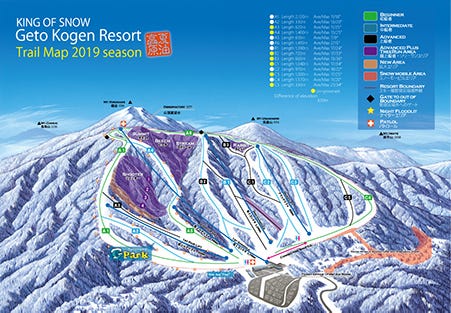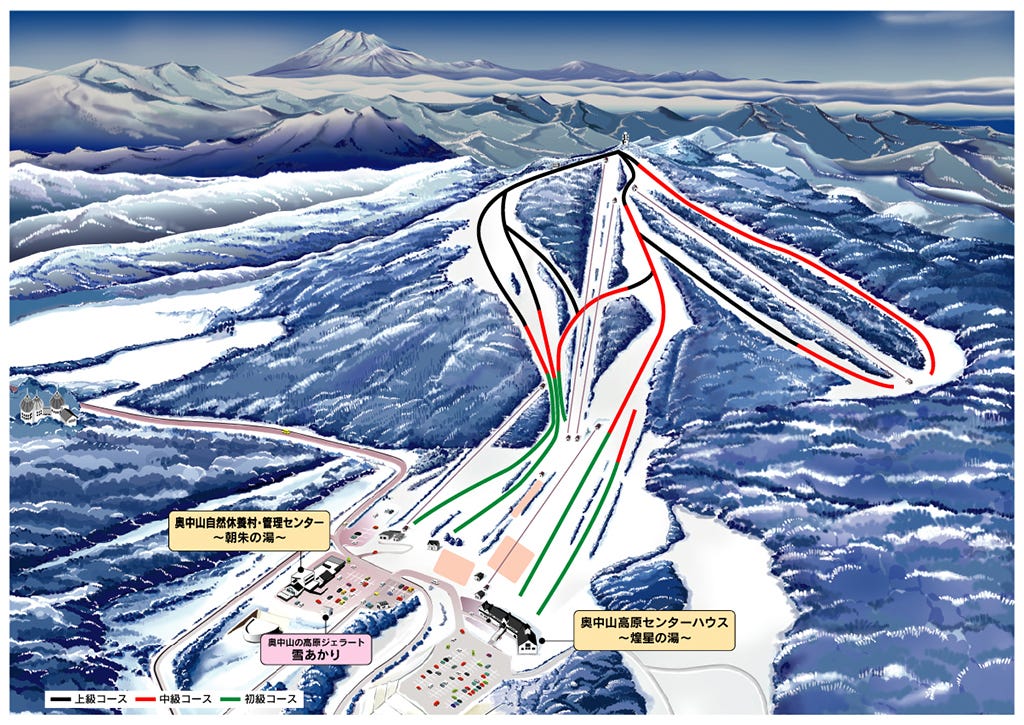Indy Pass Adds Four Ski Areas in Japan
Additions of Geto Kogan, Tazawako, Okunakayama Kogen, and Shimokura/Panorama Give Indy Passholders access to 76 ski areas
Indy Pass today added four ski resorts in Northern Japan: Geto Kogan, Tazawako, Okunakayama Kogen, and Shimokura/Panorama. These are Indy’s first partners outside of North America, and they collectively bring the pass’ roster to 76 partners for the 2021-22 ski season. Passholders get two days of skiing at each. There are no blackouts in Japan. For skiers intimidated by the notion of traveling into and through the country, Indy has forged a partnership with Japan Ski Tours, and a contest could send entrants there for free (details below).
For North Americans, skiing Japan can be an exotic, otherworldly experience. The Sea of Japan, situated between mainland Asia and the island nation, is perhaps the world’s greatest snow machine, producing snowfall totals that make Little Cottonwood Canyon look like Tampa Bay. There’s a reason both Vail and Alterra have forged partnerships in Japan. Indy Pass now joins them, adding a global dimension to North America’s best bargain megapass.
Here’s more about what this partnership means for Indy Pass and its passholders:
Resort breakdown: enough snow to bury a giraffe
My normal statistical breakdown of new Indy Pass partners is not going to work here. Mostly because almost no one in Japan seems to keep track of how much it snows at any given resort. Indy Pass’ press release puts it somewhere between 40 and 60 feet. I guess it’s like trying to count grains of sand on the beach. How much sand is there? Man, I don’t know, a fuckload. Does it matter if there’s five or seven fuckloads of sand on a given day? It really doesn’t. However much there is, there’s enough sand, and in this case enough snow, for everyone.
In the interest of keeping this post family-friendly, I have invented a new unit of snow measurement called the Giraffe. One Giraffe equals 18 feet, which is the maximum height of an adult male giraffe. One giraffe equals, I don’t know, three fuckloads. And since most Japanese resorts that do measure snow calculate the average depth on any given day, rather than the amount of new snow, and since this average is calculated in “CMs” (like I’m supposed to JUST KNOW how many Giraffes that equals), the average annual snowfall totals below are just estimates.
There are some other quirks to Japanese skiing nomenclature: runs are called “courses”; double chairs are “pair lifts”; everything is measured in something called “the metric system,” which as a U.S. American I’m incapable of understanding in relation to our own archaic and incomprehensible measurement system, which seems to have been imported whole from some Dark Ages fable about gnomes and goblins. Why the entire world can’t settle on a measurement system as it has on, say, a time-keeping system I have no idea. Anyway, the mountains:
Geto Kogen
430 meter-vertical drop (1,411 feet); 14 courses; 5 lifts (2 gondolas, 1 quad, 2 pair lifts); 2.8 Giraffes of annual snowfall
Tazawako
608-meter vertical drop (1,995 feet); 13 courses; 6 lifts (2 quads, 4 pair lifts); per Powderhounds, “It snows a mighty lot at Tazawako, although not even Ullr the snow god or Chione the snow goddess knows how much falls…” let’s call it 3.5 Giraffes of annual snowfall based upon that thorough analysis.
Okunakayama Kogen
358-meter vertical drop (1,175 feet); 11 courses; 5 pair lifts; trying to figure out how much it snows here is like asking a Sugarbush parking lot attendant how many Subarus he’s seen in his lifetime; let’s just call it 2.5 to 3 Giraffes, which is like 7.5 to 9 fuckloads, so more than enough.
Shimokura/Panorama
Shimokura: 550-meter vertical drop (1,804 feet); 20 courses; 3 lifts (1 triple, 2 pairs)
Panorama (not that Panorama): 460-meter vertical drop (1,509 feet); 7 courses; 4 lifts (1 quad, 3 pairs)
The resorts are side-by-side. Indy says that Shimokura “gets positively dumped with high-quality super-light snow.” So let’s call it 3 to 4 Giraffes of annual snowfall.
Statistically these don’t seem huge so tell me why I would fly all the way to Japan to ski these?
OK I’ll try. It’s hard to describe skiing in Japan. According to Tazawako’s website, it’s “very crazy and very fun!” Well, you have my attention. A broader view: Japan has “around 500” operating ski areas, according to Snow Japan. That’s more than the United States (470 as of 2020), which has two-and-a-half times Japan’s population. Two-thirds of Japan’s mountains have no snowmaking. National Geographic says that Niseko (where Ikon has partners), has recorded up to 1,500 inches of snow in a single year. That’s nearly seven Giraffes! The snow also tends to be extremely light and high-quality: see this comparison of Niseko snows to those of Utah, Alaska, Europe, and other ski centers. While Indy’s four partners are not on Hokkaido, the island where Niseko is located, they still get Giraffes worth of snow.
Japan is not, however, known for Snowbird-style steeps or rowdy cliff-hucking faces. The terrain is mostly mellow, but it’s also mostly wide-open. The number of “courses” on a given trailmap is largely irrelevant: the whole mountain is usually skiable, the trees widely spaced, the powder often untouched. I mean this could be you:
But the universe of Japanese skiing is dense and enormous. You can browse this chart breaking down some of the country’s most prominent resorts. It’s still a lot to process. You could do worse than just building a trip around the four Indy resorts – there are plenty of bolt-on skiing and après options. “The region is brimming with cat skiing, backcountry skiing, tree skiing, and bountiful side-country,” Indy Pass tells us, “in addition to temples, traditions, authentic accommodations, and hot springs that offer a truly once-in-a-lifetime experience.”
Another Indy step into the destination world
I have to admit I’m a little ambivalent about these international add-ons to North American megapasses. Not because I don’t acknowledge the quality of the skiing elsewhere, but because the notion of a bargain ski pass is at odds with two realities: international flights are expensive, and lift tickets outside of the United States typically are not. A one-day lift ticket at Tazawako is approximately $37. Average airfare to Japan is between $950 and $1,700, and that just gets you to Tokyo, five hours (and around $150) by train and bus to the resort.
So I’m probably not buying a $279 Indy Pass just because it provides eight days of skiing in Japan, just as I’m not throwing down on the $783 Epic Pass or the $1,049 Ikon Pass for their international options. But it’s a cool add-on if I’m in search of novelty or am a Points Guy Bro who figured out how to rack up 8 million airline miles using only my monthly Netflix subscription fee.
And it was important that Indy branched out. The pass, which is only two years old, has taken important steps to maximize its appeal, establishing a coast-to-coast resort network with density in most core skiing markets. The additions of Jay Peak, Cannon, Waterville Valley, and Saddleback in the Northeast; Lutsen and Granite Peak in the Midwest; and Powder Mountain and many others in the West have transformed Indy into a true destination product, a viable bargain alternative to the Epic and Ikon Passes. The addition of Japan adds an extra dimension to this broad and growing network.
Indy Pass founder Doug Fish has told me on The Storm Skiing Podcast that he could envision up to 90 partners on the pass. I think the number could be substantially higher if he added similar networks of freewheeling independents in Europe, Australia, New Zealand, and South America. There’s likely little risk in doing so, as it’s become clear that maximizing an Indy Pass is next to impossible. Fish says the most days anyone has clocked on one pass in a single season is 31; the most resorts, 17. If Indy has, say, 90 in North America, it could probably have around half that scattered across the world without materially raising the pass price.
I was trying not to use the word “Japow” in this article but that’s what they named the contest
Indy Pass founder Doug Fish acknowledges the logistical obstacles of these resort additions. “Powder skiing in Japan is not for everyone, but by adding these beautiful, independent resorts and culturally rich region to the Indy Pass, we give people something to dream about,” he said.
And if you don’t have cash or a bling-bling points account, you can enter to win a “Japow Dream Trip,” which includes a seven-day, all-expense-paid trip for two, including round-trip airfare, transportation, lodging, meals, two pairs of Atomic Bent Chetler skis, and two Indy Passes. Enter here.
For those cobbling together the trip on their own, Indy’s partnership with Japan Ski Tours, which provides “optional guide and concierge services,” is an interesting option. The resorts are only a few hours apart, but the challenges of navigating an unfamiliar country and culture can be heavily mitigated with the help of professionals.
“At Japan Ski Tours we’ve been specializing in off-the-beaten-track ski experiences for seven years and can provide everything from all-inclusive guided trips to white-glove airport-to-airport service to ensure that your dream ski vacation goes off without a hitch,” said Brent Potter, mountain guide and co-owner of Japan Ski Tours.
It’s unclear how much these trips cost, but details should be available on Indy’s website. Frankly whatever you pay will likely be well worth it in terms of saved hassle and access to safe pow stashes.
Indy cleans up its website
While it’s unrelated to this announcement, it’s worth noting that Indy has finally cleaned up the resorts section of its website, which used to feel like navigating through a garage sale, with everything randomly arranged. The site split its three regions into five: West, Rockies, Midwest, East, and Mid-Atlantic. They are finally, thank heavens, sorted by state. Indy says more website updates are forthcoming, and I’ll provide full updates as it evolves.
Indy Pass on The Storm Skiing Podcast
Caberfae Peaks, Michigan Co-Owner and GM Tim Meyer
Titus Mountain Co-Owner Bruce Monette Jr. (recorded pre-Indy)
Indy Pass Founder Doug Fish (April 27, 2021 – 2nd appearance)
West Mountain, New York owners Sara and Spencer Montgomery (recorded pre-Indy)
Montage Mountain Managing Owner Charles Jefferson (recorded pre-Indy)
Granite Peak, Wisconsin GM Greg Fisher
Waterville Valley, New Hampshire GM Tim Smith
Bolton Valley, Vermont President Lindsay DesLauriers
Saddleback, Maine GM Andy Shepard (recorded pre-Indy)
Jay Peak, Vermont GM Steve Wright
Cannon Mountain, New Hampshire GM John DeVivo
Indy Pass Founder Doug Fish (May 31, 2020 – 1st appearance)
Berkshire East and Catamount, Massachusetts Owner Jon Schaefer
Magic Mountain, Vermont President Geoff Hatheway








